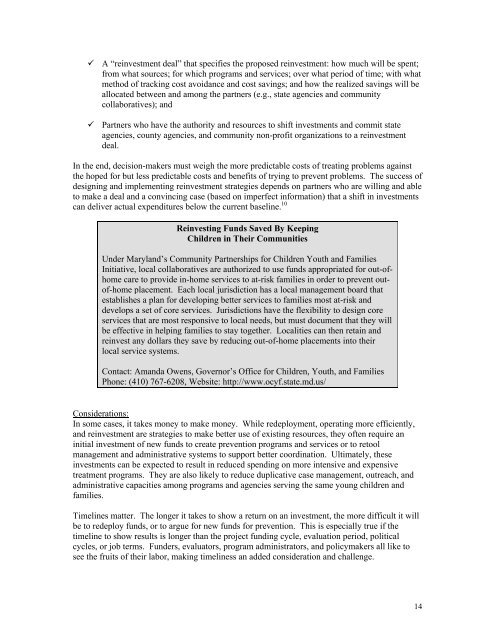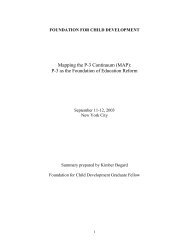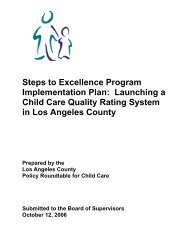STRATEGIC FINANCING: - National Academy for State Health Policy
STRATEGIC FINANCING: - National Academy for State Health Policy
STRATEGIC FINANCING: - National Academy for State Health Policy
Create successful ePaper yourself
Turn your PDF publications into a flip-book with our unique Google optimized e-Paper software.
A “reinvestment deal” that specifies the proposed reinvestment: how much will be spent;<br />
from what sources; <strong>for</strong> which programs and services; over what period of time; with what<br />
method of tracking cost avoidance and cost savings; and how the realized savings will be<br />
allocated between and among the partners (e.g., state agencies and community<br />
collaboratives); and<br />
Partners who have the authority and resources to shift investments and commit state<br />
agencies, county agencies, and community non-profit organizations to a reinvestment<br />
deal.<br />
In the end, decision-makers must weigh the more predictable costs of treating problems against<br />
the hoped <strong>for</strong> but less predictable costs and benefits of trying to prevent problems. The success of<br />
designing and implementing reinvestment strategies depends on partners who are willing and able<br />
to make a deal and a convincing case (based on imperfect in<strong>for</strong>mation) that a shift in investments<br />
can deliver actual expenditures below the current baseline. 10<br />
Reinvesting Funds Saved By Keeping<br />
Children in Their Communities<br />
Under Maryland’s Community Partnerships <strong>for</strong> Children Youth and Families<br />
Initiative, local collaboratives are authorized to use funds appropriated <strong>for</strong> out-ofhome<br />
care to provide in-home services to at-risk families in order to prevent outof-home<br />
placement. Each local jurisdiction has a local management board that<br />
establishes a plan <strong>for</strong> developing better services to families most at-risk and<br />
develops a set of core services. Jurisdictions have the flexibility to design core<br />
services that are most responsive to local needs, but must document that they will<br />
be effective in helping families to stay together. Localities can then retain and<br />
reinvest any dollars they save by reducing out-of-home placements into their<br />
local service systems.<br />
Contact: Amanda Owens, Governor’s Office <strong>for</strong> Children, Youth, and Families<br />
Phone: (410) 767-6208, Website: http://www.ocyf.state.md.us/<br />
Considerations:<br />
In some cases, it takes money to make money. While redeployment, operating more efficiently,<br />
and reinvestment are strategies to make better use of existing resources, they often require an<br />
initial investment of new funds to create prevention programs and services or to retool<br />
management and administrative systems to support better coordination. Ultimately, these<br />
investments can be expected to result in reduced spending on more intensive and expensive<br />
treatment programs. They are also likely to reduce duplicative case management, outreach, and<br />
administrative capacities among programs and agencies serving the same young children and<br />
families.<br />
Timelines matter. The longer it takes to show a return on an investment, the more difficult it will<br />
be to redeploy funds, or to argue <strong>for</strong> new funds <strong>for</strong> prevention. This is especially true if the<br />
timeline to show results is longer than the project funding cycle, evaluation period, political<br />
cycles, or job terms. Funders, evaluators, program administrators, and policymakers all like to<br />
see the fruits of their labor, making timeliness an added consideration and challenge.<br />
14

















